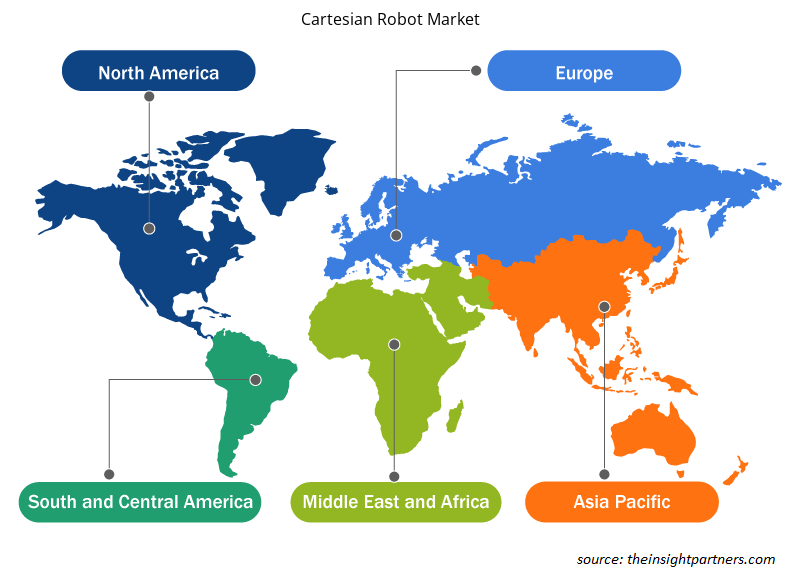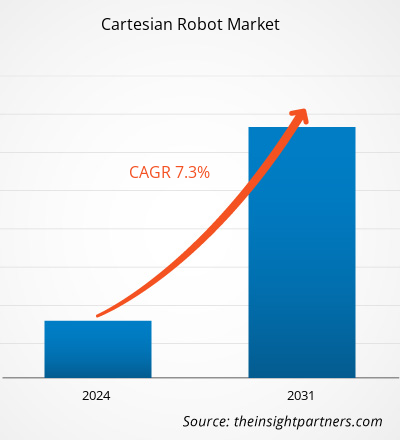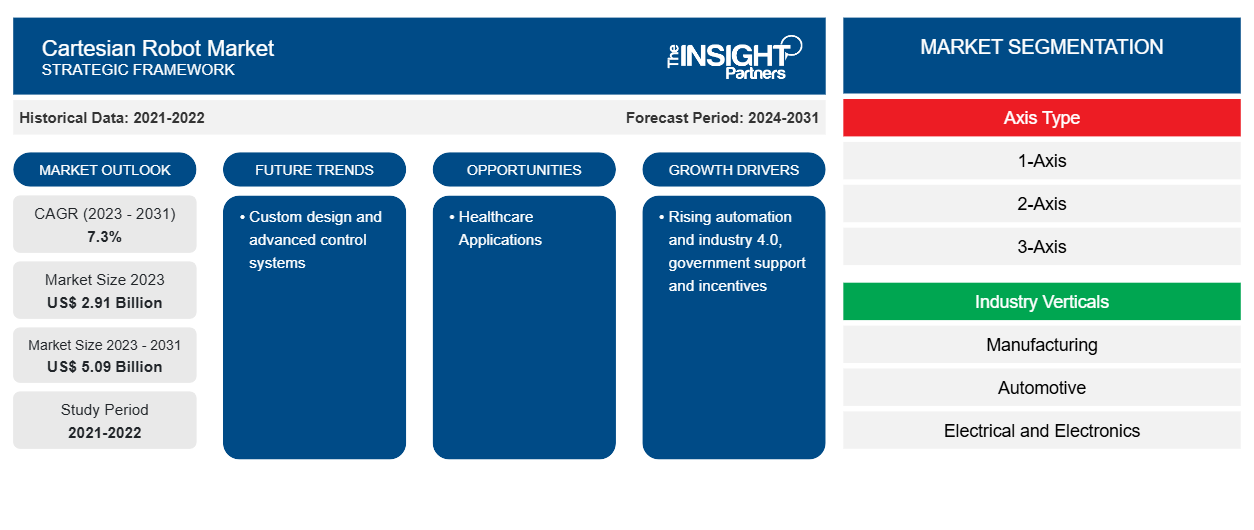预计到 2031 年,直角坐标机器人市场规模将从 2023 年的 29.1 亿美元增至 50.9 亿美元。预计 2023-2031 年市场复合年增长率将达到 7.3%。定制设计和先进控制系统可能仍是直角坐标机器人市场的主要趋势。
直角坐标机器人市场分析
直角坐标机器人、线性机器人和龙门机器人均指沿线性轴移动的机电一体化机器人。龙门机器人与龙门起重机类似,动作也类似。然而,龙门机器人的功能不仅限于举升和移动。它们可以根据需求具有特定功能。
笛卡尔机器人市场概况
笛卡尔机器人是一种流行且简单的 机器人技术,制造商已经使用了几十年。各个行业和应用的企业都在从这种可扩展技术中获益。笛卡尔机器人是目前用途最广泛的机器人平台。这种扩展既扩展到其潜在的物理尺寸,也扩展到极限强度。笛卡尔机器人可以像微型 3D 打印机一样小,也可以根据需要大到一定大小。现在有许多巨大的笛卡尔机器人,长度为 50 米(164 英尺)或更长。这是由于机械原理。齿条和小齿轮执行器使制造商能够构建非常大的系统。它们的机械原理也是现代机器人平台上最强大的。
定制此报告以满足您的需求
您可以免费定制任何报告,包括本报告的部分内容、国家级分析、Excel 数据包,以及为初创企业和大学提供优惠和折扣
- 获取此报告的关键市场趋势。这个免费样品将包括数据分析,从市场趋势到估计和预测。
笛卡尔机器人市场驱动因素和机遇
自动化程度不断提高和工业 4.0 受到市场青睐
工业自动化领域正在发生翻天覆地的变化。人工智能 (AI)、协作机器人和物联网集成等技术的进步是推动这一增长的少数驱动因素之一。无数制造商使用工业机器人来实现工作自动化、提高工人安全性、提高整体生产率,同时降低浪费和运营费用。随着工业机器人在制造环境中变得越来越普遍,对适合特定应用和行业的各种类型的工业机器人的需求也越来越大。例如,根据 2024 年的一份报告,现在世界上有超过 340 万台工业机器人。工业领域全球机器人与人类的比例为 1:71。工业企业打算在未来五年内将 25% 的资本投资于工业自动化。IoT integration are among the few drivers driving this growth. Countless manufacturers employ industrial robots to automate jobs, improve worker safety, and boost overall production output while lowering waste and operating expenses. As industrial robots become more common in manufacturing environments, there is a greater demand for various types of industrial robots to suit certain applications and industries. For instance, according to a 2024 report, there are more than 3.4 million industrial robots in the world now. The global robot-to-human ratio in the industrial business is 1:71. Industrial enterprises intend to invest 25% of their capital in industrial automation over the next five years.
医疗保健应用——笛卡尔机器人的机遇
笛卡尔机器人在医疗程序自动化中发挥着重要作用。2020 年 12 月,Allia IGS 7 血管造影系统是 GE Healthcare 用于图像引导治疗的最新一代机器人驱动血管造影系统。它在 2020 年北美放射学会 (RSNA) 虚拟会议期间亮相。该系统不是安装在地板上或天花板上,而是在带轮子的龙门架上操作,可以将其停在不妨碍的地方,以便更方便地接触患者或转换为开放式手术。机器人龙门架采用激光引导,以确保在房间内精确定位,并允许在固定式 C 臂系统上使用先进的成像和引导技术。笛卡尔机器人在这些关键医疗应用中的应用正在为市场创造机会。
笛卡尔机器人市场报告细分分析
有助于得出笛卡尔机器人市场分析的关键部分是轴类型和行业垂直。
- 根据轴类型,笛卡尔机器人市场分为 1 轴、2 轴、3 轴和 4 轴。3 轴部分在 2023 年占据了最大的市场份额。
- 根据行业垂直,笛卡尔机器人市场分为制造业、汽车业、电气和电子业、食品和饮料业、化学品和石化产品等。
笛卡尔机器人市场份额按地区分析
笛卡尔机器人市场报告的地理范围主要分为五个区域:北美、亚太、欧洲、中东和非洲、南美/南美和中美。
亚太地区在笛卡尔机器人市场占据主导地位。中国、印度、日本等亚太国家工业化程度的提高推动了该地区对笛卡尔机器人的需求。笛卡尔机器人市场在北美正在经历长足的发展,这可以归因于汽车和制造业等一些工业领域的显著增长。
笛卡尔机器人市场区域洞察
Insight Partners 的分析师已详细解释了预测期内影响笛卡尔机器人市场的区域趋势和因素。本节还讨论了北美、欧洲、亚太地区、中东和非洲以及南美和中美洲的笛卡尔机器人市场细分和地理位置。

- 获取笛卡尔机器人市场的区域特定数据
笛卡尔机器人市场报告范围
| 报告属性 | 细节 |
|---|---|
| 2023 年的市场规模 | 29.1亿美元 |
| 2031 年市场规模 | 50.9 亿美元 |
| 全球复合年增长率(2023 - 2031) | 7.3% |
| 史料 | 2021-2022 |
| 预测期 | 2024-2031 |
| 涵盖的领域 | 按轴类型
|
| 覆盖地区和国家 | 北美
|
| 市场领导者和主要公司简介 |
|
市场参与者密度:了解其对商业动态的影响
笛卡尔机器人市场正在快速增长,这得益于终端用户需求的不断增长,这些需求源于消费者偏好的不断变化、技术进步以及对产品优势的认识不断提高等因素。随着需求的增加,企业正在扩大其产品范围,进行创新以满足消费者的需求,并利用新兴趋势,从而进一步推动市场增长。
市场参与者密度是指在特定市场或行业内运营的企业或公司的分布情况。它表明在给定市场空间中,相对于其规模或总市场价值,有多少竞争对手(市场参与者)存在。
在笛卡尔机器人市场运营的主要公司有:
- ABB
- 日本电装波浪股份有限公司
- 美的集团。
- 精工爱普生公司。
- 芝浦机械株式会社
- 雅马哈摩托车有限公司
免责声明:上面列出的公司没有按照任何特定顺序排列。

- 获取笛卡尔机器人市场顶级关键参与者概览
笛卡尔机器人市场新闻和最新发展
通过收集初步和二次研究后的定性和定量数据来评估笛卡尔机器人市场,其中包括重要的公司出版物、协会数据和数据库。以下是笛卡尔机器人市场的发展和战略列表:
- KUKA Robotics 在 2021 年汉诺威工业博览会上推出了一款用于其协作和工业机器人手臂的全新操作系统。全新 KUKA iiQKA.OS 操作系统旨在“像手机一样简单易用”。新操作系统设计的基本目的是使其足够简单,以便新操作员无需经过专门培训即可使用。这是一个重要的软件设计目标,尤其是在协作机器人领域。(来源:KUKA AG,新闻稿,2021 年)
笛卡尔机器人市场报告覆盖范围和交付成果
“笛卡尔机器人市场规模和预测(2023-2031)”报告对以下领域进行了详细的市场分析:
- 范围内所有主要细分市场的全球、区域和国家层面的市场规模和预测
- 市场动态,如驱动因素、限制因素和关键机遇
- 未来主要趋势
- 详细的 PEST/波特五力分析和 SWOT 分析
- 全球和区域市场分析涵盖关键市场趋势、主要参与者、法规和最新市场发展
- 行业格局和竞争分析,涵盖市场集中度、热点图分析、知名参与者和最新发展
- 详细的公司简介
- 历史分析(2 年)、基准年、预测(7 年)及复合年增长率
- PEST和SWOT分析
- 市场规模、价值/数量 - 全球、区域、国家
- 行业和竞争格局
- Excel 数据集
近期报告
相关报告
客户评价
购买理由
- 明智的决策
- 了解市场动态
- 竞争分析
- 客户洞察
- 市场预测
- 风险规避
- 战略规划
- 投资论证
- 识别新兴市场
- 优化营销策略
- 提升运营效率
- 顺应监管趋势





















 获取免费样品 - 笛卡尔机器人市场
获取免费样品 - 笛卡尔机器人市场